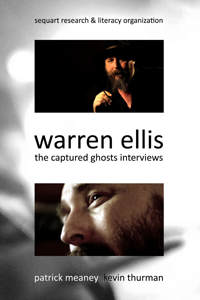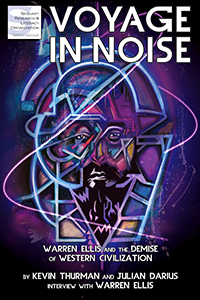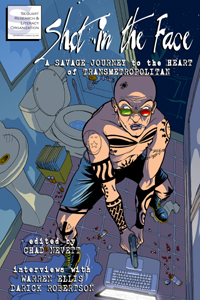On Christmas Day 2013, my brother gave me a booster pack of random, non-sequential issues from a variety of popular comic book titles that syndicated in the late eighties to mid nineties. The nineties was a time of groundbreaking work in the comic community that gave birth to the age of modern comics. Sometimes, not so much. These are snapshots of the industry at its best and worst. This is Brian’s Comic Book Grab Bag.
Ghost Rider Annual #2 cover, the direct edition.
Ghost Rider Annual Volume 3 #2
“Wish for Pain”
Writer – Warren Ellis
Penciler – Javier Saltares
Inker – Mike Witherby
Letterer – Lorina Mapa
I will be honest, until twenty minutes ago, I had never bothered to read up on what a comic “annual” actually was. It occurred to me, seeing this word floating around in the pool of need-to-know jargon that I probably should, so I looked it up.
Annuals have a share in comic book history, or recent history to be exact. There was a time, back when I was a wee lad in the early nineties, that comics had nearly collapsed altogether when a certain “bubble” burst, not unlike the crash in the housing market in 2007-2008. A large percentage of comic retailers (two-thirds, according to Wikipedia) were run out of business because of the marketing gimmicks and cajoling on the part of comic publishers to buy, sell, and collect seemingly worthless scraps of paper. Many well to do content creators such as Valiant and First Comics (of which this series has covered two choice properties to date) were unable to sell their wares causing them to go bankrupt or be sold off to outside investors. Marvel filed bankruptcy in 1997, demonstrating the frightening precedent that even Stan Lee could be dethroned from his self distributing empire. The comic “annual” is just one example amidst a slew of others that represent the burgeoning greed of a market desperate for capitalizing on growing readership.
Scarecrow doing some home redecorating.
Frankly, the end result is much similar to the stand-up comedy craze of the early nineties that likewise busted, when sitcoms featuring up-and-coming comics became so prevalent that the viewer base became oversaturated. Despite this, each bust paved the way to the creation of niche communities that led to a revival in the respective markets. Zach Galifianakis, Patton Oswalt, Demetri Martin, et al are the prospective offspring that were birthed out of the resuscitation of stand-up comedy, leading to better, atypically experimental style, especially Flight of the Conchords, which became a mainstream success in 2007 due to their exposure on late-night television programs such as David Letterman and Conan O’Brien in June of ’07. Flight of the Conchords (at least in this writer’s humble opinion) became a gateway act into the more obscure and groundbreaking material that would coalesce throughout the early 2000s, revitalized by Adult Swim and internet based comedy outlets like CollegeHumor and Funny Or Die.
Now this trend is presenting in the comicbook communities that are finding new life in internet based publishing, thereby eliminating the massive overhead expenses associating with traditional publishing methodology, as well as expedited ease and delivery of content to the consumer base. Crowdsourcing has further catalyzed the proliferation of independent creator owned content. Jason Brubaker, creator of reMIND, an internet based graphic novel, successfully raised $107,542 according to his Kickstarter page. The novel accountability created by crowdsourcing is two fold: to the creator first, then the readership. The creator is impressed to create top-notch content, while the readers support the creator with venture capital to fund the prospective projects. Jason’s philosophy is rendered in his forthcoming book, Unnatural Talent (the printing of which was funded entirely by Kickstarter):
If you’re self-publishing a book then the least of your problems is coming up with the money to print your book. The biggest problem is selling your books. So in other words, if you don’t know if you can sell your books, then you shouldn’t be printing them in the first place. I made this mistake with my very first comic in 2006. I printed 1,000 copies with my own money and decided I’d worry about selling them once I got them. Well, I still have them sitting in my garage to this day. You see, I was worrying about the wrong thing. Fast forward to 2010: I received a grant for $5,000 and raised another $12,600 in preorders through Kickstarter before I even printed my book. (Brubaker, 71)
This healthy synergy produces great content, as exhibited by Brian K. Vaughan’s The Private Eye, which is being released either free of charge, or for scalable donations. Many others have proven the metal of grassroots productivity. My own graphic novel, set to debut this November, will likely leverage this same distribution and crowdsourcing model.
Scarecrow: Mayor Giuliani's proxy for the city's "homeless problem."
Ghost Rider Annual #2 then, represents a unique position in the publishing history of comics. Within the epic 64 pages, are three stories, the majority of press associated with Warren Ellis’s Wish For Pain issue contained within the volume. The latter two, Raising Cain and Truck Stop, seem to be end matter, filler stories giving context to whatever extant storylines were in print at the time (this was the primary purpose of annuals). I can only imagine the chagrin Marvel execs felt when they sent the issue off to print, as 1994 places this particular annual during the onset of the comicbook bust of 1993-1997. To the credit of the annual, Warren Ellis’s story is actually very good.
Warren’s start with Marvel began in 1994, which is intriguing, given that this annual would have marked a standalone debut, one which would have commanded the attention of the Ghost Rider niche at the time. The comic as it is, features a layered story, with complex imagery interlaced throughout the panels that harkens back to Scarecrow’s original conceptions as a circus contortionist. Ghost Rider takes his time and breaks Scarecrow’s body, but allows his bones to heal in place crooked, thereby inverting Scarecrow’s special abilities with considerable irony. The juxtaposition of fear and vengeance is troubling because how the two are interrelated, or counteract one another, isn’t clearly described in the comic. I assume that vengeance overrides fear because it is an active force, an imposition upon someone else, whereas fear is elicited. The latter is dependent upon the victim, which Ghost Rider thwarts by his ability to resist Scarecrow’s threats and intimidation. The best material derives itself from the B-plot, a backstory weaved into the narrative that explains Scarecrow’s origins as a villain. Here, he is given an identity common to most serial killers. The caveat of being a serial killer though is that his ability to instill fear is undermined by his insecurities—namely his need to escape pain, symbolized by Scarecrow’s uncanny ability to escape compromising situations. Fear becomes a method of control, a way to commute submission and mask inner turmoil. Scarecrow solicits the fear of others because he cannot healthily experience it himself.
Ghost Rider confronts Scarecrow in the climax fight.
It’s a shame that the issue ends with a whimper. The logic of why Ghost Rider is more powerful than Scarecrow is ambiguously defined, if not hastily compiled. I can only assume that there is canonical significance in the ending, but the issue itself thwarts the conceptions of the novice readership. Given the timing of Ghost Rider Annual #2, reader accessibility was paramount in the survival of the series. Without this, the end result is an impenetrable, though intriguing, crime drama with no subtlety, just a growling skull and a wannabe DC villain.
6 Meat Bags (of 10)

























































How many comics did you receive in your booster pack? It just seems that this “Grab Bag” series has been going on quite a while. I got booster packs of comics when I was a kid and I was lucky if I got even 6 comics! Just saying that this feels way more then that. Well, great articles you’ve been doing by the way.